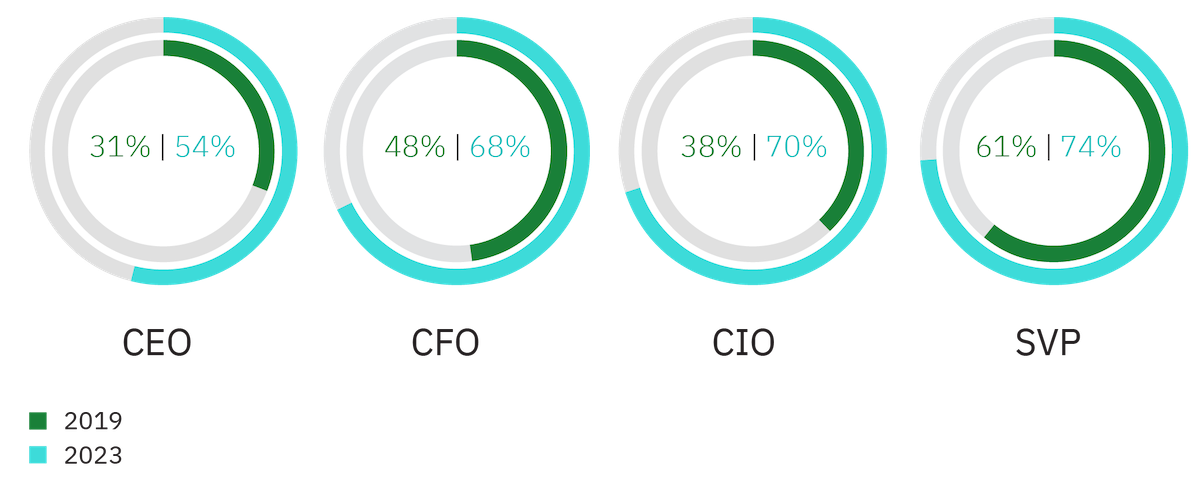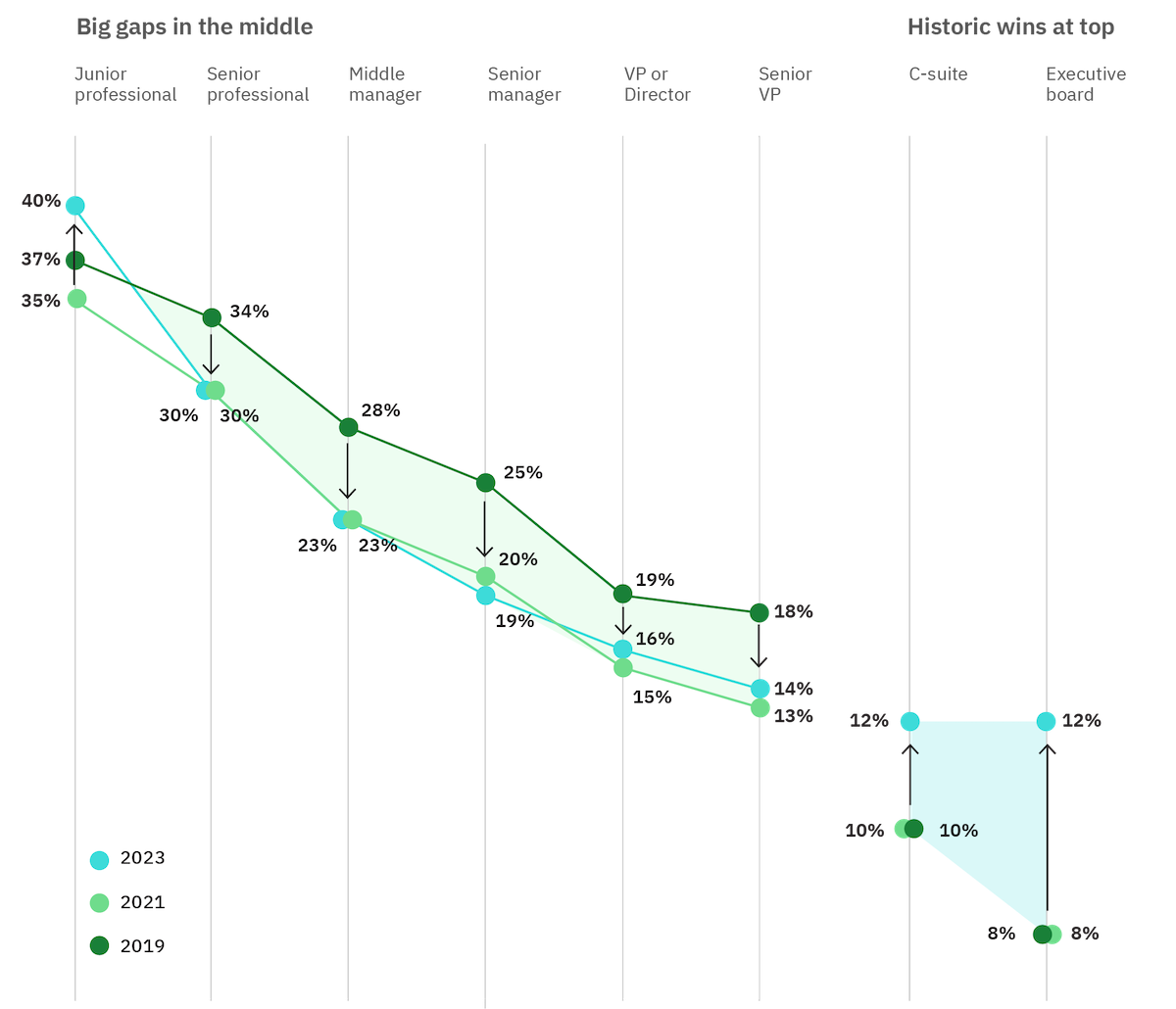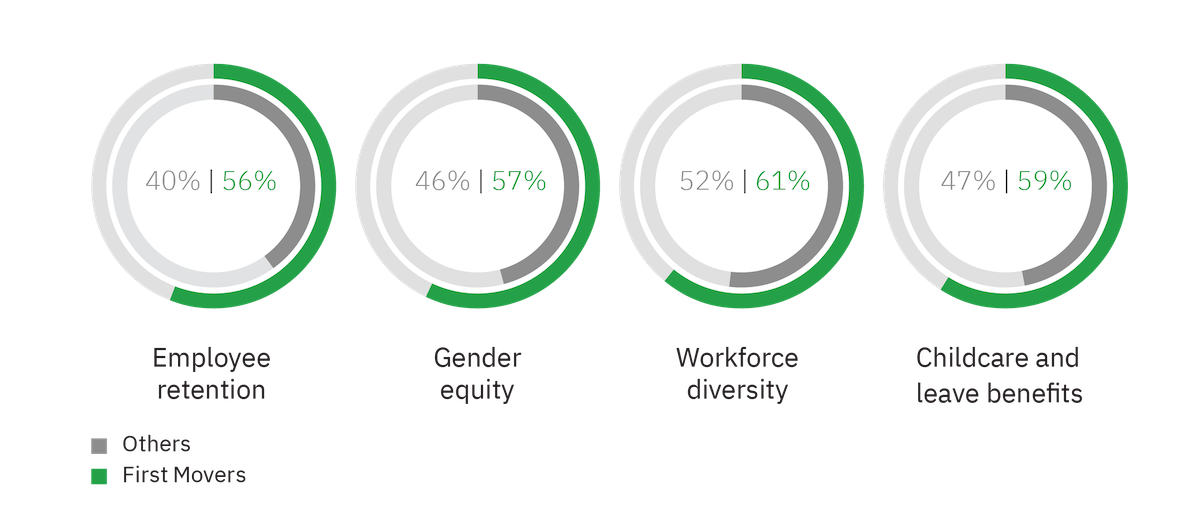More women than ever before have joined the highest echelons of corporate power. In 2023, 12% of C-Suite and board roles are held by women. That’s the highest percentage to date. It’s also a record that’s made to be broken. Many of us expect this number to tick up at least gradually, if not by leaps and bounds, each year. But new research shows that’s unlikely to happen any time soon.
Enduring biases and corporate complacency threaten the future of women’s professional advancement, according to Chief’s latest report with the IBM Institute for Business Value (IBV) on the Women in Leadership: Why Perception Outpaces the Pipeline — and What to Do About It. Based on a global survey of more than 2,500 organizations, deep-dive interviews, and qualitative insights from Chief Members, the report shows that while gender parity “feels” close, it’s actually getting farther away.
Confidence in Women’s Advancement Reaches an All-Time High
People now think it will take just 10 years to reach gender parity in leadership within their industry. This is a huge drop since IBM IBV’s 2019 survey on women in leadership, where respondents said it would take more than 50 years. This year’s report also identified a significant uptick in men’s perception of women’s suitability for leadership roles. For the first time, the majority of men surveyed don’t see gender as a barrier to joining their organization’s highest ranks.

Today, far more men think that women in their organizations have an equal shot at top leadership positions.
This confidence is backed by tangible commitments to the advancement of women at work. The majority of companies are implementing programs designed to help women advance their careers. For example, 78% provide career development planning specific to women’s needs, 74% require job succession plans to include women candidates, and 68% hold senior management accountable for gender equity with performance metrics. Additionally, the percentage of organizations that have made advancing more women into leadership roles a top formal business priority has nearly doubled in just two years, from 25% in 2021 up to 45% in 2023.
It all adds up to what seems to be a justifiably sunny outlook. But as anyone who has fought to increase equity across any dimension can tell you, that’s a trap. Progress rarely follows a simple s-curve. Wins do not always inspire further action. They can often have the opposite effect, instead breeding overconfidence that quickly slips into complacency. That, our report finds, is the case with women’s professional advancement today.
In Reality, the Women Leadership Pipeline Is Broken
In examining the pipeline of current and future women leaders, we do see some growth at both ends. The percentage of women serving in C-Suite and board positions has increased (from 10% and 8%, respectively, in 2021 to 12% for both in 2023), as has the percentage of women in junior professional/specialist roles, which grew from 35% in 2021 to 40% in 2023. But across the remainder of the pipeline, the percentage of women has hollowed out, worsening since the pandemic.

The 2023 leadership pipeline of women: Historic percentages in the most senior roles, but a stubborn stagnation of women in roles between junior professional and the C-suite.
2023 saw the largest drop yet of women taking that first managerial advancement from a junior professional to senior with a gap of 10%.
The report saw women massively exiting the workforce from mid-level leadership tiers that feed the C-Suites and boards of tomorrow. The percentage of women in middle management dropped from 28% in 2019 to 23% in 2023, while the percentage of women in senior management dropped from 25% to 19%. This trend continues along the pipeline, with the percentage of women in VP/Director roles falling by 3 percentage points, and SVP roles dropping by 4 percentage points since 2019.
Given the current state of the pipeline, when we do the math, we see it is impossible to achieve gender parity within the next ten years — despite abundant optimism. Analysts at the IBM IBV calculate that, given the current rate of change, C-suite roles may reach gender parity within 32 years. For other leadership roles — from Senior VP and VP down to middle management where growth is flat or has declined — we will never see gender parity.
Despite Programs and Promises, Gender Bias Remains Entrenched
The research finds that bias against women endures in many workplaces, especially at the middle management level. Fewer than half (48%) of male managers say leadership believes women are as effective at supervising as men. And when asked if women with dependent children are as dedicated to their jobs as women without children, only 40% of male managers agree that this is what leaders in their organization believe.
Additionally, professionals of all genders and levels ascribed different qualities for men versus women to be considered for leadership roles. For women to be promoted to leadership, respondents ranked “strategic and visionary,” and “open and transparent communicator,” as top qualities. For men, they needed to be “innovative,” “have integrity,” and be “analytical, logical, and results-oriented.”

The prioritized attributes needed for promotion to a leadership role differ for women and men.
What we can draw from these differing requirements is that we want women leaders to inspire us, communicate well and help everyone feel good at work in addition to being qualified for the job, while male leaders are expected to simply deliver results. The fix isn’t to expect less from women leaders, though, but to ask more from men.
What We’re Doing Now Won’t Work for Tomorrow — and We’re Leaving Money on the Table Today
If the current slate of programs designed to attract and retain women were making an impact, we would not see such pervasive bias around women’s leadership capabilities. The pipeline would be much healthier; achieving gender parity would not be such a distant dream. The current state is, clearly, broken.
Fixing the pipeline problem won’t be easy, but it’s also not a sisyphean task. We find that those who have committed to fixing the problem are already seeing results. We analyzed a subset of organizations called the First Movers that share three key characteristics.
- They have made the advancement of women a top formal business priority.
- They view gender inclusivity as a driver of financial performance.
- They believe that businesses need to continue making changes if they are to achieve gender parity.
Compared to other organizations in the sample, the First Movers report 19% higher revenue growth and outperform on employee retention, gender equity, workforce diversity, and caregiving benefits.

More First Movers are outperforming their competition on key workplace metrics and initiatives.
The First Movers also have at least 2% more women in senior leadership roles compared to all others in the sample. This is an important step in the right direction, but it’s a far cry from achieving gender parity across the enterprise.
Clearly, bigger and bolder action is needed — now. To learn more about the current state of women in leadership and the steps needed to improve the pipeline, see the full report from Chief and the IBM IBV.
